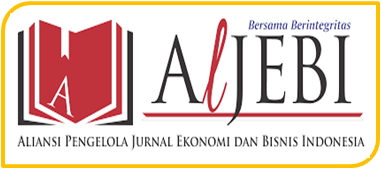Islamic Commercial Bank Performance: The Nexuses by Financial Ratios, Macro Economics, And Financial Technology
Abstract
Keywords
Full Text:
PDFReferences
Abrigo, M. R. M., & Love, I. (2016). Estimation of Panel Vector Autoregression in Stata. The Stata Journal: Promoting Communications on Statistics and Stata, 16(3), 778–804. https://doi.org/10.1177/1536867X1601600314
Ahmad Tibrizi Soni, W., Arief, M., Titis, M., & Muhammad Khaerul, M. (2023). Bitcoin Vs Gold: Which One is the Most Powerful in Boosting the Shariah Equity Index? Global Evidence. Studies in Business and Economics, 18(1), 5–36. https://doi.org/10.2478/sbe-2023-0001
Alwi, H. H., Parmitasari, N. A., & Pamungkas, I. D. (2021). The Role of Non-Performing Asset, Capital, Adequacy and Insolvency Risk on Bank Performance: A Case Study in Indonesia. Journal of Asian Finance, Economics and Business, 8(3), 319–329.https://doi.org/10.13106/jafeb.2021.vol8.no3.0319
Asari, F. F. A. H., Baharuddin, N. S., Jusoh, N., Mohamad, Z., Shamsudin, N., & Jusoff, K. (2011). A Vector Error Correction Model (VECM) Approach in Explaining the Relationship Between Interest Rate and Inflation Towards Exchange Rate Volatility in Malaysia. World Applied Sciences Journal, 12(Bolstering Economic Sustainability), 49–56.
Bag, S., & Islam, S. (2017). Non-Performing Assets a Biggest Challenge in Banking Sector- a Comparative Study Between India and Bangladesh Banking Sector. ICTACT Journal on Management Studies, 3(4), 620–624. https://doi.org/10.21917/ijms.2017.0084
Bahri, E. S., Zam-zamiyah, F. T., & Nasution, N. (2022). The Measurement of The Financial Performance of Islamic Commercial Banks in Indonesia With The Maqashid Sharia Index and Comparative Performance Index Approach. MALIA: Journal of Islamic Banking and Finance, 6(2), 131. https://doi.org/10.21043/malia.v6i2.16634
Boţa-Avram, C., Groşanu, A., Răchişan, P.-R., & Gavriletea, M. (2018). The Bidirectional Causality between Country-Level Governance, Economic Growth and Sustainable Development: A Cross-Country Data Analysis. Sustainability, 10(2), 502. https://doi.org/10.3390/su10020502
Bruns, S. B., & Stern, D. I. (2019). Lag length selection and p-hacking in Granger causality testing: prevalence and performance of meta-regression models. Empirical Economics, 56(3), 797–830. https://doi.org/10.1007/s00181-018-1446-3
Burhanudin, M. P., Marota, R., & ... (2019). … Rupiah Terhadap Kinerja Keuangan Pada Perusahaan Sub Sektor Makanan Dan Minuman Yang Terdaftar Di Bursa Efek Indonesia …. Jurnal Online Mahasiswa …, 1–27. https://jom.unpak.ac.id/index.php/akuntansi/article/view/2029
Canggih, C., Nurafini, F., & Suryaningsih, S. A. (2022). A RE ISLAMIC BANKS STILL SOUND AMIDST THE PANDEMIC ? 10(2), 114–129.
Chinedu Innocent, E., Ifeoma Mary, O., & Monday Matthew, O. (2013). Financial Ratio Analysis as a Determinant of Profitability in Nigerian Pharmaceutical Industry. International Journal of Business and Management, 8(8), 107–117. https://doi.org/10.5539/ijbm.v8n8p107
Devianto, Y., & Dwiasnati, S. (2018). Banking Health Assessment Using CAMELS And RGEC Methods, Using OJK’s Banking Financial Statement Data. International Journal Of Engineering And Computer Science (IJECS), 7(8), 24187–24196. https://doi.org/10.18535/ijecs/v7i8.03
Dewi, F. A., & Sudarmawan, B. N. (2022). Finance Performance: Reinvestigation through Intellectual Capital and Good Corporate Governance. Maliki Islamic Economics Journal, 2(2), 106–122. https://doi.org/10.18860/miec.v2i2.18358
Diantini, N. K. N., Gunadi, I. G. N. B., & Suarjana, I. W. (2020). Pengaruh Capital Adequacy Ratio (Car), Efisiensi Operasional (Bopo), Risiko Bisnis, Dan Loan To Deposit Ratio (Ldr) Terhadap Kinerja Keuangan (Studi Empiris Pada Perusahaan Perbankan Yang Terdaftar di Bursa Efek Indonesia Tahun 2015-2017). EMAS-Jurnal IImiah Ilmu Ekonomi, Manajemen Dan Bisnis, 1(1), 88.101. http://www.elsevier.com/locate/scp
Dwiningsih, S. (2023). Analisis Pengaruh Kecukupan Modal ( CAR ) dan Likuiditas ( LDR ) terhadap Kinerja Keuangan ( ROA ) Keuangan Bank Swasta Nasional Tahun 2014-2018 ( Studi Pada Bei Bank Swasta Nasional ). JAMIN : Jurnal Aplikasi Manajemen Dan Inovasi BisnisJurnal Aplikasi Manajemen Dan Inovasi Bisnis, 5(2), 190–204.
Gutierrez, C. E. C., Souza, R. C., & Guillén, O. T. de C. (2009). Selection of Optimal Lag Length in Cointegrated VAR Models with Weak Form of Common Cyclical Features. Brazilian Review of Econometrics, 29(1), 59. https://doi.org/10.12660/bre.v29n12009.2696
Hayati, I., Saragih, D. H., & Siregar, S. (2019). The Effect Of Current Ratio , Debt To Equity Ratio And ROA On Stock Prices In Sharia Based Manufacturing Companies In Indonesia Stock Exchange. Proceeding International Seminar on Islamic Studies, 1(1), 10–11. http://journal.umsu.ac.id/index.php/insis/article/view/4137
Heikal, M., Khaddafi, M., & Ummah, A. (2014). Influence Analysis of Return on Assets (ROA), Return on Equity (ROE), Net Profit Margin (NPM), Debt To Equity Ratio (DER), and current ratio (CR), Against Corporate Profit Growth In Automotive In Indonesia Stock Exchange. International Journal of Academic Research in Business and Social Sciences, 4(12). https://doi.org/10.6007/ijarbss/v4-i12/1331
Ilaboya, O. J., & Ohiokha, I. F. (2016). Firm Age, Size and Profitability Dynamics: A Test of Learning by Doing and Structural Inertia Hypotheses. Business and Management Research, 5(1). https://doi.org/10.5430/bmr.v5n1p29
Indriwati, L., & Purwana, A. E. (2021). Pengaruh Capital Adequacy Ratio, Inflasi, Dan Gross Domestic Product Terhadap Return on Assets (Studi Pada Bank Umum Syariah Non Devisa Di Indonesia Periode Tahun 2018-2020). Niqosiya: Journal of Economics and Business Research, 1(1), 110–122.
Jebran, K., Chen, S., & Tauni, M. Z. (2017). Islamic and conventional equity index co-movement and volatility transmission: Evidence from Pakistan. Future Business Journal, 3(2), 98–106. https://doi.org/10.1016/j.fbj.2017.05.001
Khasanah, U., Tibrizi, A., & Wicaksono, S. (2021). Intermediary performance of Islamic banks in the disruption era: Does it contribute to economic growth? Banks and Bank Systems, 16(1), 103–115. https://doi.org/10.21511/bbs.16(1).2021.10
Kim, D. W., Yu, J. S., & Hassan, M. K. (2018). Financial inclusion and economic growth in OIC countries. Research in International Business and Finance, 43(October 2016), 1–14. https://doi.org/10.1016/j.ribaf.2017.07.178
Kohar Mudzakar, M., & Wardanny, I. P. (2021). The Effect Of Return On Asset, Return On Equity, Earning Per Share, And Price Earning Ratio Toward Stock Return (Empirical Study Of Transportation). Turkish Journal of Computer and Mathematics Education, 12(8), 387–392. www.idx.co.id
Li, X., Feng, H., Zhao, S., & Carter, D. A. (2021). The effect of revenue diversification on bank profitability and risk during the COVID-19 pandemic. Finance Research Letters, 43(December 2020), 101957. https://doi.org/10.1016/j.frl.2021.101957
Ma’ruf, M. (2021). Pengaruh Fintech Terhadap Kinerja Keuangan Perbankan Syariah. Yudishtira Journal : Indonesian Journal of Finance and Strategy Inside, 1(1), 42–61. https://doi.org/10.53363/yud.v1i1.53
Merko, F., & Habili, M. (2023). Impact of interest rate, exchange rate, and inflation on commercial banks’ performance. Corporate and Business Strategy Review, 4(2), 15–28. https://doi.org/10.22495/cbsrv4i2art2
Miranti, T., Aulia, N. A., & Pimada, L. M. (2022). How the Covid-19 Outbreak Affect the Efficiency of Islamic Rural Banks? El Dinar, 10(1), 56–68. https://doi.org/10.18860/ed.v10i1.15577
Montagnoli, A., Mouratidis, K., & Whyte, K. (2021). Assessing the cyclical behaviour of bank capital buffers in a finance-augmented macro-economy. Journal of International Money and Finance, 110, 102256. https://doi.org/10.1016/j.jimonfin.2020.102256
Nath Sahu, T., Bandopadhyay, K., & Mondal, D. (2014). An empirical study on the dynamic relationship between oil prices and Indian stock market. Managerial Finance, 40(2), 200–215. https://doi.org/10.1108/MF-06-2013-0131
Ningsih, S., & Dewi, M. W. (2020). Analisis Pengaruh Rasio NPL, BOPO Dan CAR Terhadap Kinerja Keuangan Pada Bank Umum Konvensional Yang Terdaftar Di BEI. Jurnal Akuntansi Dan Pajak, 21(01), 71–78. https://doi.org/10.29040/jap.v21i1.1159
Ningsih, S., & Widyana Dewi, M. (2020). Analisis Pengaruh Rasio NPL , BOPO Dan CAR Terhadap Kinerja Keuangan Pada. Jurnal Akuntansi Dan Pajak, 21(1), 71–78.
Phan, D. H. B., Narayan, P. K., Rahman, R. E., & Hutabarat, A. R. (2020). Do financial technology firms influence bank performance? Pacific Basin Finance Journal, 62(November 2019), 101210. https://doi.org/10.1016/j.pacfin.2019.101210
Popović-Pantić, S., Semenčenko, D., & Vasilić, N. (2020). Digital technologies and the financial performance of female smes in Serbia: The mediating role of innovation. Economic Annals, 65(224), 53–81. https://doi.org/10.2298/EKA2024053P
Pratama, A. S. (2018). PENGARUH TINGKAT BI RATE DAN GDP (GROSS DOMESTIC PRODUCT) TERHADAP KINERJA BISNIS DAN SOSIAL PERBANKAN SYARIAH DI INDONESIA DENGAN KONSEP RISK MANAJEMEN DAN KECUKUPAN MODAL SEBAGAI VARIABEL INTERVENING. Iqtishoduna, 14(1), 41–54. https://doi.org/https://doi.org/10.18860/iq.v0i0.4908
Pruteanu-Podpiera, A., Weill, L., & Schobert, F. (2008). Banking competition and efficiency: A micro-data analysis on the Czech banking industry. Comparative Economic Studies, 50(2), 253–273. https://doi.org/10.1057/palgrave.ces.8100248
Pujiyanty, L., Puspita, R. E., & Mochlasin, M. (2022). Measuring the Role of Non-Performing Financing in Boosting Profitability of Islamic Commercial Banks. El Dinar, 10(1), 1–15. https://doi.org/10.18860/ed.v10i1.12955
Putra, I., & Dana, I. (2016). Pengaruh Profitabilitas, Leverage, Likuiditas Dan Ukuran Perusahaan Terhadap Return Saham Perusahaan Farmasi Di Bei. E-Jurnal Manajemen Universitas Udayana, 5(11), 249101.
Putri, I. S., Dkw, Y. T., & Hanifah, U. (2022). ProBank : Jurnal Ekonomi Dan Perbankan ISSN : 2579-5597 ( online ) ISSN : 2252-7885 ( cetak ) The Effect of CAMEL Ratio on The Financial Performance ( Case Study on Go Public Banking Listed on The Indonesia Stock Exchange Period 2017-2021 ) Dampak Rasio C. 7(2), 173–184.
Rakshit, B., & Bardhan, S. (2022). An empirical investigation of the effects of competition, efficiency and risk-taking on profitability: An application in Indian banking. Journal of Economics and Business, 118(August 2020), 106022. https://doi.org/10.1016/j.jeconbus.2021.106022
Ratanapakorn, O., & Sharma, S. C. (2007). Dynamic analysis between the US stock returns and the macroeconomic variables. Applied Financial Economics, 17(5), 369–377. https://doi.org/10.1080/09603100600638944
Restianti, T., & Agustina, L. (2018). The Effect of Financial Ratios on Financial Distress Conditions in Sub Industrial Sector Company. Accounting Analysis Journal, 7(1), 25–33. https://doi.org/10.15294/aaj.v5i3.18996
Salsabila, R., Wicaksono, A. T. S., & Shamakov, N. (2022). The Role of Early Warning System Components in Financial Distress: Evidence from Indonesian Islamic Banks. Maliki Islamic Economics Journal, 2(2), 123–138. https://doi.org/10.18860/miec.v2i2.18977
Sanjay Dawn. (2018). NON-PERFORMING ASSETS ( NPAs ): A STUDY OF UCO BANK. EPRA International Journal OfEconomic and Business Review, 6(7), 88–92.
Santhi, N. (2022). an Evaluation, Comparison and Management of Non Performing Assets (Npa) in State Bank of India & Its Associates. EPRA International Journal of Economics, Business and Management Studies (EBMS), 9(12), 32–41. https://doi.org/10.36713/epra1013
Saputra, F. E., & Lina, L. F. (2020). Analisis Faktor-Faktor Yang Mempengaruhi Kinerja Keuangan Bank Umum Syariah Yang Terdaftar Di Bursa Efek Indonesia (Bei) Periode 2016-2018. TECHNOBIZ : International Journal of Business, 3(1), 45. https://doi.org/10.33365/tb.v3i1.657
Shenurti, E., Erawati, D., & Nur Kholifah, S. (2022). Analisis Return on Asset (ROA) , Return on Equity (ROE) dan Corporate Social Responsibility (CSR) yang mempengaruhi Nilai Perusahaan pada Perusahaan Manufaktur. Jurnal Akuntansi Dan Manajemen, 19(01), 01–10. https://doi.org/10.36406/jam.v19i01.539
Sholikah, A. M., & Miranti, T. (2020). Factors influence financial sustainability banking in Indonesia. Al-Tijary Jurnal Ekonomi Dan Bisnis Islam, 6(1), 41–50.
Silva, P. H. N., & de Araújo, J. M. (2023). Inflation, perception of economic uncertainty and COVID-19: Evidence from Central Bank communication. Central Bank Review, 23(1), 100108. https://doi.org/10.1016/j.cbrev.2023.100108
Sudarmawanti, E., & Pramono, J. (2017). PENGARUH CAR, NPL, BOPO, NIM DAN LDR TERHADAP ROA (Studi kasus pada Bank Perkreditan Rakyat di Salatiga yang terdaftar di Otoritas Jasa Keuangan Tahun 2011-2015). Among Makarti, 10(1), 1–18. https://doi.org/10.52353/ama.v10i1.143
Sumarta, N. H. (2000). Bulletin of Monetary Economics and Banking TERDAFTAR DI BURSA EFEK INDONESIA DAN THAILAND. 3(2).
Syahwildan, M., & Damayanti, T. (2022). Fintech terhadap Kinerja Keuangan Perbankan Syariah di Indonesia. Jesya (Jurnal Ekonomi & Ekonomi Syariah), 5(1), 438–443. https://doi.org/10.36778/jesya.v5i1.608
Tan, Y. (2016). The impacts of risk and competition on bank profitability in China. Journal of International Financial Markets, Institutions and Money, 40, 85–110. https://doi.org/10.1016/j.intfin.2015.09.003
Tanted, N., Gupta, R., & Gaykwad, A. (2021). A STUDY OF NPA AND ITS IMPACT ON BANKING PERFORMANCE. https://doi.org/10.31794/NLDIMSR.5.2.2021.14-25
Taylor, D. (2022). Did diversified and less risky banks perform better amid the pandemic? Economics Letters, 211, 110251. https://doi.org/10.1016/j.econlet.2021.110251
Tursoy, T. (2018). Munich Personal RePEc Archive Risk management process in banking industry. Munich Personal RePEc Archive, 86427, 1–37. https://mpra.ub.uni-muenchen.de/86427/1/MPRA_paper_86427.pdf
Wahyuni, E. (2018). Satanic Finance Dalam Perbankan Syariah. ILTIZAM Journal of Sharia Economic Research, 2(1), 20. https://doi.org/10.30631/iltizam.v2i1.109
Wang, L. (2023). Central bank asset purchases, banks’ risky security holdings and profitability: Macro and micro evidence from Japan and the U.S. International Review of Economics and Finance, 87(April), 347–364. https://doi.org/10.1016/j.iref.2023.04.022
Wang, Z., & Tang, K. (2020). Combating COVID-19: health equity matters. Nature Medicine, 26(4), 458. https://doi.org/10.1038/s41591-020-0823-6
Widyastuti, E. (2022). Instrumen Makroekonomi dan Pengaruhnya terhadap Kinerja Keuangan Bank Umum di Indonesia Selama Pandemi Covid-19. Jurnal Masharif Al-Syariah: Jurnal Ekonomi Dan …, 7(1), 212–230. http://103.114.35.30/index.php/Mas/article/view/9637
Yudaruddin, R., soedarmono, wahyoe, Nugroho, B. A., Fitrian, Z., Mardiany, M., Purnomo, A. H., & Santi, E. N. (2023). Financial technology and bank stability in an emerging market economy. Heliyon, 9(5), e16183. https://doi.org/10.1016/j.heliyon.2023.e16183
Yunus, N. (2012). Modeling relationships among securitized property markets, stock markets, and macroeconomic variables. Journal of Real Estate Research, 34(2), 127–156. https://doi.org/10.1080/10835547.2012.12091331
DOI: https://doi.org/10.18860/miec.v3i1.21719
Refbacks
- There are currently no refbacks.

This work is licensed under a Creative Commons Attribution-ShareAlike 4.0 International License.
Editorial Office:
Megawati Soekarnoputri Building
Faculty of Economics
Jln. Gajayana 50 Telp (0341) 558881
E-mail: m-iecjournal@uin-malang.ac.id
UIN Maulana Malik Ibrahim Malang
Member of:
Indexed by:
Maliki Islamic Economics Journal under a CC BY SA 4.0 International License.
View My Stats

























